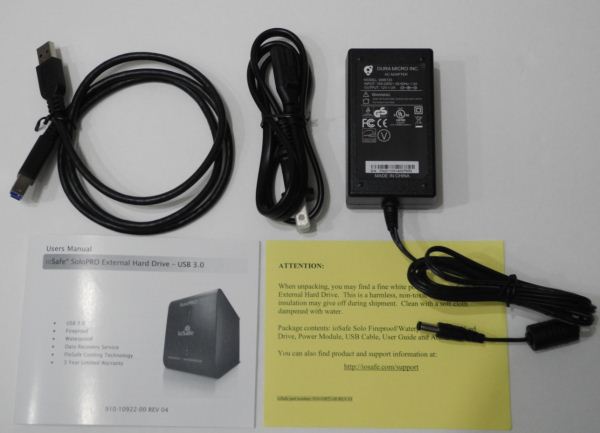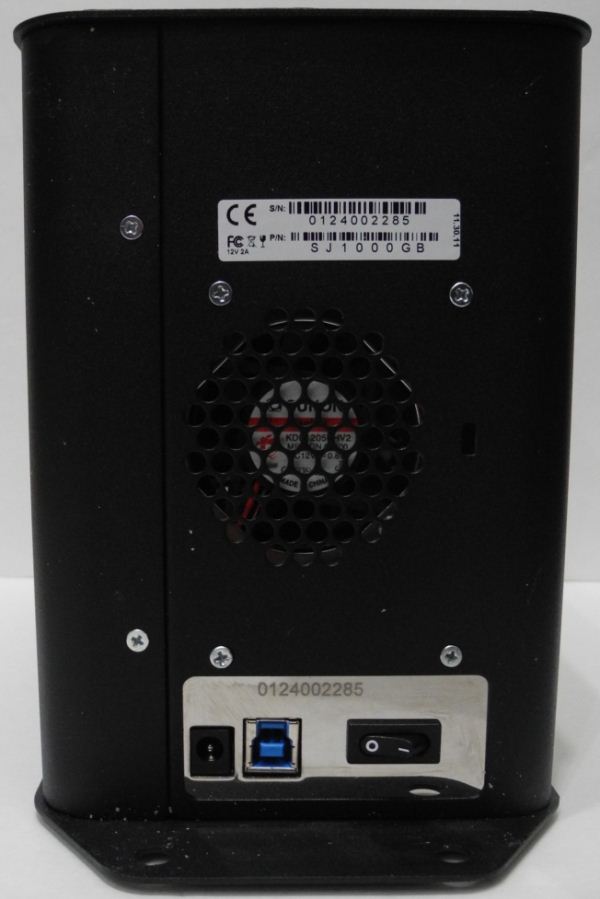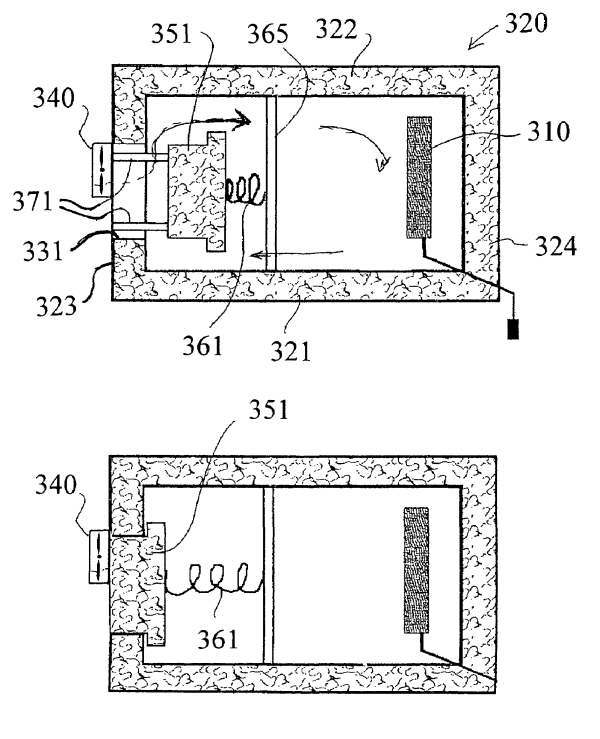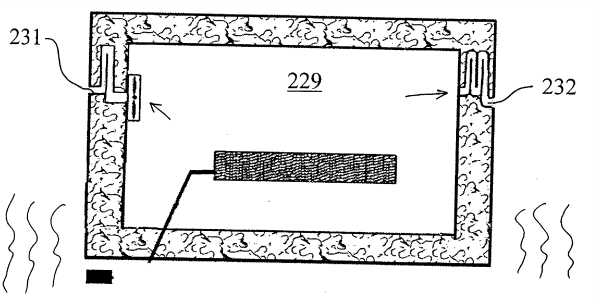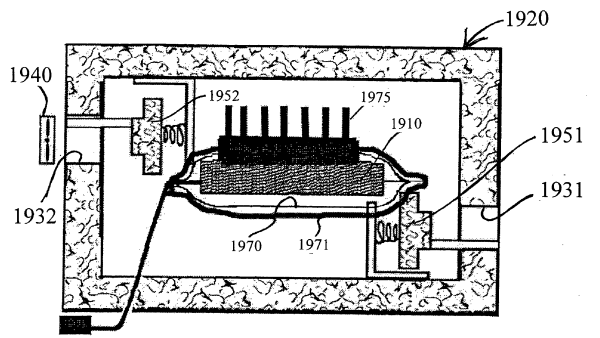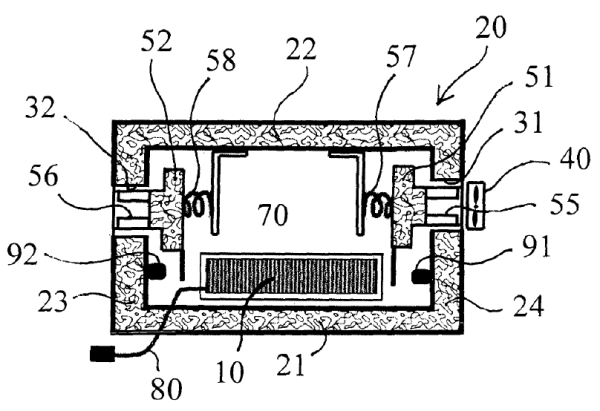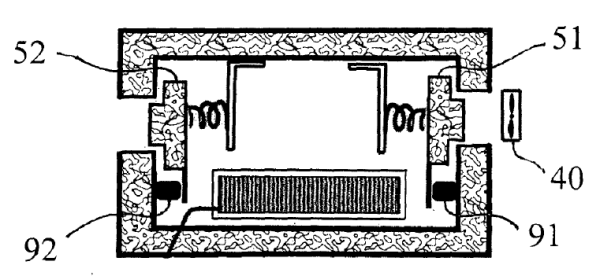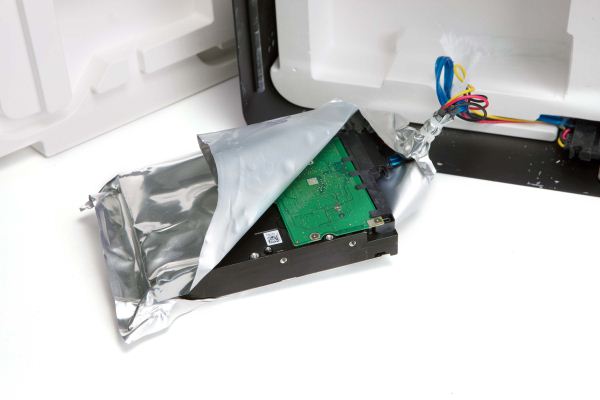
Original Link: https://www.anandtech.com/show/5731/iosafe-solopro-disaster-proofing-your-storage-needs
ioSafe SoloPRO: Disaster Proofing Your Storage Needs
by Ganesh T S on April 9, 2012 6:00 PM EST- Posted in
- Storage
- IT Computing
- ioSafe
Consumers understand the importance of keeping their documents and other material possessions safe from unexpected disasters. Towards this, many invest in fireproof and waterproof safes. However, as the digital economy grows, many of the possessions such as documents and photo albums are in terms of bits and bytes, rather than tangible things which can be placed in safes. This brings to fore the necessity to find a disaster-proof safe place for those bits and bytes in both personal and business settings.
Storage media (hard disks, in particular) are quite sensitive to environmental conditions, and protecting them from disasters such as fires and floods is an interesting problem. ioSafe has been in the business of selling disaster proof storage solutions for the last 7 years. Their products have been well-reviewed and their CES demonstrations have always drawn a large audience. We received a ioSafe SoloPRO 1TB USB 3.0 version to take out on a test drive. The unit protects data from loss up to 1550°F for 1/2 hour as per ASTM E119 and it is also waterproof upto 10 ft. for 72 hours.
Package Contents and Initial Impressions:
The ioSafe SoloPRO package was surprisingly heavy, coming in at 18 lbs. In addition to the main unit, it came with a 24 W power adapter, a USB 3.0 cable, a user manual and a note about the possibility of fireproof insulation powder being present on the external surface of the unit.
The main unit alone weighed in at a hefty 15.5 lbs. Its dimensions are 5" x 7.1" x 11". The rear side of the main unit has an explicit on-off switch, the USB 3.0 connector and the power inlet. There is also a fan in the unit for active cooling of the hard drive.
On connecting the unit to the computer, we found that the unit internally uses a Seagate Barracuda 7200 rpm 1 TB hard drive with a 32 MB buffer. The USB 3.0 port is provided by JMicron's JMS539 SuperSpeed USB to SATA II 3.0G bridge.
Those are the tangibles in the shipment. What else does one get? The SoloPRO unit comes with a Data Recovery Service (DRS) package, 1 year of which is included in the purchase price. The SoloPRO allows for this to be upgraded to either 3 or 5 years at an extra cost of $50 or $100 respectively. The warranty in the US market is for 3 years, but a 5 year upgrade to DRS automatically extends the warranty to 5 years.
The DRS provides for one instance of no-questions-asked data and hardware recovery. The user mails the affected unit back to ioSafe (shipping paid by ioSafe) and the recovered data is loaded onto another ioSafe unit. In case the data is not recoverable through ioSafe's usual procedures, the company provides upto $2500 in coverage for data recovery by a third party.
Consumers have to explicitly register online with ioSafe for DRS to be enabled on their unit. There is a lot of information (some of which is unnecessary, in our opinion) that needs to be entered while registering. Upon successful registration, one is also provided with a single user license for Genie Timeline Pro, a software to aid in backups (say, to a SoloPRO). The software costs $59.95 when bought standalone, but is complimentary with the purchase of an ioSafe SoloPRO.
The ioSafe SoloPRO 1TB version with USB 3.0 support comes with a MSRP of $349.99, a premium of more than $200 over a comparable non-disaster proof version. What is the technology that is worth this premium? Let us see in the next section.
ioSafe holds a number of patents related to disaster proofing of digital storage media. ioSafe's CEO Robb Moore is the primary inventor of most of those patents. In this section, we will take a brief look at the various patents related to the ioSafe SoloPRO. Note that the SoloPRO might not be using all of the inventions mentioned in the patents below.
Fire Resistant, Forced Air Cooled Enclosure for Computer Digital Data Storage Device (US Patent No. US 7,211,742 B2):
This patent provides details of how ioSafe is able to design a fireproof enclosure despite the presence of a fan to cool the operating contents. Even though a single hard disk drive used as a backup target (such as in the SoloPRO) might not require active cooling, it is definitely a necessity in multi-disk configurations.
The invention presents a fireproof enclosure with an inlet for air to flow through (aided by a fan) and cool the storage device inside. However, this inlet could prove detrimental in case of a fire (where the exposure of the internal storage device to high temperatures / fire through the inlet could cause its destruction).
To solve this problem, the opening is protected by a fire resistant movable hatch. This movable hatch automatically closes upon reaching a predetermined temperature (which is something not reached by the drives during operation, and also below something which can actually damage the drives). The closing mechanism could use any temperature sensitive element (eutectic metal / plastic / rubber / wax etc.) coupled with either actuation springs that expand or contract to close the hatch or just rely on gravity to bring the hatch down (if the temperature sensitive element is actually supporting the top of the enclosure). An alternative to a mechanical closing system is an electronic solenoid based system where the actuator is a thermocouple.
Example of springs being used as actuators to close hatch held in place by a temperature sensitive element (Diagrams from Patent No. US 7,211,742 B2). Note that this is not the actual mechanism used in the SoloPRO.
In each of the above methods, a temperature sensitive element is activated when a threshold temperature is reached, which protects the internal data storage device from the high external temperature.
Fire Resistant and/or Water Resistant Enclosure for Operable Computer Digital Data Storage Device (US Patent No. US 2009/0050365 A1):
This patent details inventions which provide for hatchless enclosures (with or without fans), water resistant and non-actively cooled enclosures (with or without hatches), and enclosures with meltable materials which can close off ventilation passageways in the case of a fire.
The movable hatches described in the previous patent tend to increase the cost of the device. In this patent, ioSafe describes how a 1.5 inch thick gypsum wall with small sized vents could support fan-based cooling while also protecting the internal contents from the high temperatures outside. In the presence of a fire, the air inside expands and gets forced out through the vents. This outward air flow counteracts the flow of external heat through the vents. The vents are designed to be maze-like to reduce the amount of external heat which can get inside. Of course, the inner chamber and the vents have to be appropriately sized to provide fire resistance and prevent data loss.
Labyrinthine vents to allow for expanding internal air volume to counter the external heat (Diagram from Patent No. US 2009/0050365 A1)
The SoloPRO is also water resistant, and this patent also describes the water resistant and heat conducting covering for the data storage device. In addition, the patent also presents how intumescent or meltable materials can be used to seal off the inlets for the power and data cables of the data storage device.
Water resistant pouch with an embedded finned heat sink to cover the storage media. Note that the SoloPRO's water resistant pouch doesn't have a finned heat sink (Diagram from Patent No. US 2009/0050365 A1)
The water resistant pouch is made of heat conducting material so that the heat produced by the drive is taken away. It could be either a metallic foil or a more rigid enclosure. The enclosure could also internally contain fins for better thermal performance. The metallic pouch is provided with an elastomeric coating. A gasket around the perimeter of the pouch provides a water resistant enclosure.
Fire Resistant and Water Resistant Enclosure for Operable Computer Digital Data Storage Device (US Patent No. US 7,843,689 B2):
This patent is the one on which a majority of the features of the SoloPRO are based. It improves upon the inventions detailed in the previous two patents by:
- Super-saturating the enclosure (made of gypsum or concrete) with water, and preventing its evaporation with vapor barriers on both the internal and external walls of the enclosure (during a fire, this barrier melts and the water in the walls absorb the latent heat of vaporization, allowing the extension of the time over which the internal storage device is protected from damage).
- Not allowing the movable hatch design to completely close off the internal unit, but allow a slight opening for superheated steam to escape (can be used for high power devices - 20 to 2000 W)
- Providing ventilation passageways for expanding air and steam inside the unit in case of a fire (in hatchless designs)
State of the enclosure prior to fire exposure. Note the size of the vents near 91 and 92 which allow for flowing air to cool the storage media during normal operation (Diagram from Patent No. US 7,843,689 B2)
State of the enclosure after fire damage. Note that the size of the vents near 91 and 92 have decreased, but they still allow steam built up internally to escape outside (Diagram from Patent No. US 7,843,689 B2)
The water resistant pouch used in this invention is similar to the one in the previously described patent.
The SoloPRO consists of two pieces of steel which interlock and are held together with screws. Inside it is the DataCast (ioSafe's trade name) endothermic insulation (which was described in the last discussed patent). Since hard drives are comparatively low power (in the 5-20 W range), a hatchless design with no moving parts is used. The HydroSafe (again, ioSafe's trade name) barrier is the water resistant enclosure described in one of the inventions listed in the second patent. The photograph below shows the internals of the ioSafe SoloPRO. Note the two zip ties used to seal the wires going into the waterproof pouch.
We looked at the technology behind ioSafe's products in the previous section and had a look into the internals just now. But, how effective is the technology? Instead of subjecting the unit to fire and water damage, and just presenting readers with results which a number of other excellent reviews have already done, we decided to concentrate on covering the technology behind the unit. That said, we went through a large number of ioSafe videos on YouTube and decided to present one particular destruction / recovery attempt which, we believe, brings across the disaster proof nature of ioSafe's offerings in a realistic scenario. Embedded below is the video review of an ioSafe unit by GearDiary's Larry Greenberg
The above video also shows how to recover the data from an ioSafe unit subject to fire and water damage. In almost all cases, however, the users just need to mail the drive back to ioSafe for data recovery (and getting another ioSafe unit with that data).
There are other videos on YouTube showing how ioSafe's offerings stand up to various destruction attempts, and we believe there was nothing we could do in our testing that could one-up those professional destruction attempts.
Home users dealing with small amounts of data can always back up their contents using cloud services like Dropbox and Box.net. Serious businesses always have an off-site tape backup or some other similar mechanism for data backup. However, the former is not suitable for large amounts of data (say, more than a few hundred GBs), and the latter is not suitable for making a disaster proof copy of recently changed files. Keeping this in consideration, it is also necessary to evaluate the performance metrics of the unit.
The ioSafe SoloPRO unit was connected to the USB 3.0 port of an ASRock Vision 3D 252B machine. Based on the Cougar Point HM65 Intel Chipset, the PC's NEC based USB 3.0 ports are able to deliver the full USB 3.0 bandwidth. We benchmarked the SoloPRO with both IOMeter and HD Tune Pro. The results are presented below. Note that the performance metrics are a very minor aspect of what the ioSafe units are all about.
IOMeter
| IOMeter Performance | |
| Test | Transfer Rate (MBps) |
| 4 KB Random Write | 0.64 |
| 4 KB Random Read | 0.27 |
| 128 KB Sequential Read | 119.0 |
| 128 KB Sequential Write | 107.8 |
HD Tune Pro
With HD Tune Pro, reads and writes to the disks benchmarked at an average of around 99 MBps. The gallery below presents HD Tune Pro screenshots for read and write benchmarks as well as random access benchmarks.
Power Consumption
At idle, the unit consumed 7.5 W (which is probably higher than the standard external hard drives due to the presence of a fan). During periods of heavy disk activity, the consumption was 9.2 W.
There is very little to not like about the ioSafe SoloPRO. It has received universal praise from all quarters for solving one of the important issues in protecting data storage media. The technology behind the units looks quite solid, and the important fact is that ioSafe currently has a track record of recovering its customers' data 99.9904% of the time. I have seen various reviews pointing to the weight and noise of the unit as drawbacks, but I don't believe they are that much of an issue in the market which ioSafe is targeting with this product.
The necessity to protect one's data from fire and water damage can't be overstressed. For small amounts of data, an online backup service should suffice. However, this is not practical when large amounts of data are involved. Many small and medium businesses continue to remain paranoid about cloud storage. In such circumstances, solutions like those provided by ioSafe are the best bet.
For the consumers, ioSafe seems to be the only game in town for disaster proof storage. The good news is that the lack of competition hasn't kept ioSafe from innovating and trying to bring down the cost of their units.
For ioSafe, the issue is not about market competition, but more about consumer awareness. Most users don't realise the need for disaster proof storage until it is too late. That said, the rise in popularity of online backups means that ioSafe has to be able to provide more storage and multi-disk configurations in their enclosures to the end users quite soon. We do have some other suggestions also for ioSafe:
- There is not much protection against mechanical drive failures. Even in the case that forensic data recovery is able to retrieve the data, availability takes a hit. Some sort of multi-drive configuration with a RAID-1 or higher array needs to come to the market.
- In addition to local storage units, NAS configurations would be a good addition to the offerings. In fact, I do see that ioSafe used to offer local RAID configurations and NAS configurations in a tie-up with ReadyNAS. Strangely, I see no mention of this in the current ioSafe site. It would be interesting to see how ioSafe reinvents its offerings in this area. That said, SoloPRO units can always be hooked up to an appropriate NAS and the drive mapped on the network for use as a disaster proof backup.
- In my initial correspondence with ioSafe, I had made it a point to enquire about their reasons for not going with enterprise class drives. ioSafe pointed me to an article suggesting that there is not much difference between the consumer and enterprise drives in terms of reliability. I am convinced about ioSafe's approach, but it is quite possible that some consumers might want enterprise class drives inside their units.
- ioSafe has some interesting patents lined up, such as the one for disaster proofing a storage device which can be used in a standard PC chassis drive bay. It would be interesting to see if ioSafe can bring a standard drive bay sized disaster proof storage module for use in PCs.


